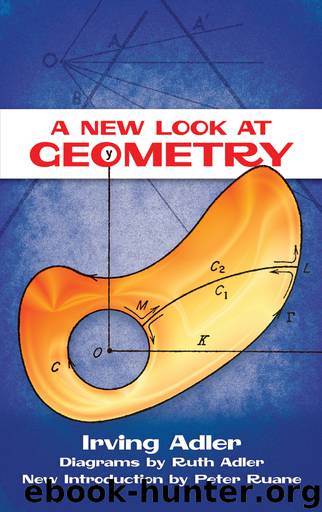A New Look at Geometry by Irving Adler

Author:Irving Adler
Language: eng
Format: epub
Publisher: Dover Publications
Published: 2013-06-26T16:00:00+00:00
The second theorem shows how 11(d) changes as d changes:
II. If PΩ is parallel to QΩ, and QP is extended to R, then the exterior angle RPΩ is greater than angle Q.
Proof: Draw angle RPS equal to angle Q. Then either (1) PS lies inside angle QPΩ, or (2) PS coincides with PΩ, or (3) PS lies inside angle RPΩ. In case (1), PS intersects QΩ at some point T to form triangle PQT. Then exterior angle RPT is equal to the opposite interior angle Q. This is impossible, by proposition 16 of Euclid’s Book I. In case (2), let M be the midpoint of PQ. Draw MN perpendicular to PΩ, extended through P if necessary. On QΩ draw QL equal to PN so that N and L lie on opposite sides of PQ, and then draw ML. Since angle Q = angle RPS = angle NPM, and QM = PM, triangles NPM and LQM are congruent. Then angle NMP = angle LMQ, and consequently NML is a straight line. Moreover, since angle MLQ = angle MNP, NL is perpendicular to QΩ. Then angle LNΩ is an angle of parallelism. But this is impossible, since angle LNΩ is a right angle, and an angle of parallelism is acute. Therefore case (3) is the only one that may arise, and in this case angle RPΩ, being greater than angle RPS, is also greater than angle Q.
Let us apply this result to the diagram below, in which two lines are drawn parallel to AΩ from points P and Q on the line QPA which is perpendicular to AΩ. If the distances of P and Q from AΩ are d and d' respectively, and d' > d, then the theorem just proved shows that II(d') < II(d). If we picture the point P as moving toward Q, we see then that as the distance from AΩ increases, the corresponding angle of parallelism decreases. It can be shown that any acute angle, no matter how small, can be obtained as an angle of parallelism corresponding to some appropriate distance. Consequently, as the distance increases toward infinity, the corresponding angle of parallelism decreases toward zero. If P moves toward A, we see that as the distance from AΩ decreases toward zero the corresponding angle of parallelism increases toward 90°. The exact way in which II(d) varies with d is given explicitly by the following formula that was derived by Bolyai and Lobatschewsky:
Download
This site does not store any files on its server. We only index and link to content provided by other sites. Please contact the content providers to delete copyright contents if any and email us, we'll remove relevant links or contents immediately.
| Applied | Geometry & Topology |
| History | Infinity |
| Mathematical Analysis | Matrices |
| Number Systems | Popular & Elementary |
| Pure Mathematics | Reference |
| Research | Study & Teaching |
| Transformations | Trigonometry |
Modelling of Convective Heat and Mass Transfer in Rotating Flows by Igor V. Shevchuk(6352)
Weapons of Math Destruction by Cathy O'Neil(6080)
Factfulness: Ten Reasons We're Wrong About the World – and Why Things Are Better Than You Think by Hans Rosling(4620)
Descartes' Error by Antonio Damasio(3185)
A Mind For Numbers: How to Excel at Math and Science (Even If You Flunked Algebra) by Barbara Oakley(3183)
Factfulness_Ten Reasons We're Wrong About the World_and Why Things Are Better Than You Think by Hans Rosling(3161)
TCP IP by Todd Lammle(3097)
Applied Predictive Modeling by Max Kuhn & Kjell Johnson(2980)
Fooled by Randomness: The Hidden Role of Chance in Life and in the Markets by Nassim Nicholas Taleb(2969)
The Tyranny of Metrics by Jerry Z. Muller(2953)
The Book of Numbers by Peter Bentley(2874)
The Great Unknown by Marcus du Sautoy(2611)
Once Upon an Algorithm by Martin Erwig(2540)
Easy Algebra Step-by-Step by Sandra Luna McCune(2538)
Lady Luck by Kristen Ashley(2495)
Practical Guide To Principal Component Methods in R (Multivariate Analysis Book 2) by Alboukadel Kassambara(2446)
Police Exams Prep 2018-2019 by Kaplan Test Prep(2441)
All Things Reconsidered by Bill Thompson III(2327)
Linear Time-Invariant Systems, Behaviors and Modules by Ulrich Oberst & Martin Scheicher & Ingrid Scheicher(2303)
